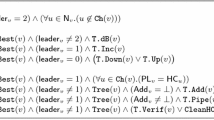Abstract
We consider the problem of electing a leader in synchronous rings of unknown size. We present a tradeoff betweentime andbits where the bit complexity is alwaysindependent of the entities values and the time is alwayslinear in the smallest entity value. We also show how to elect a leader in exactly θ(n)bits, thus matching the same bit complexity achievable whenn is known, with a time complexitypolynomial in the smallest entity values. Both results are achieved using a novel technique,double waiting, and improve significantly on the existing bounds.
Similar content being viewed by others
References
[BT] H. L. Bodlaender, G. Tel, Bit-optimal election in synchronous rings,Information Processing Letters,36(1) (1990), 53–64.
[FL] G. N. Frederickson, N. A. Lynch, Electing a leader in a synchronous ring,Journal of the Association for Computing Machinery,34 (1987), 95–115.
[FS] G. N. Frederickson, N. Santoro, Symmetry breaking in synchronous networks, inProc. 2nd Internat. Workshop on Parallel Computing and VLSI, Loutraki, July 1986 (F. Makedon, K. Mehlhorn, T. Papatheodorou, P. Spirakis, eds.), Lecture Notes in Computer Science, Vol. 227, Springer-Verlag, Berlin, pp. 26–33.
[G] E. Gafni, Improvements in the time complexity of two message-optimal election algorithms, inProc. 4th ACM Symp. on Principles of Distributed Computing, Minaki, Aug. 1985, pp. 175–185.
[IR] A. Itai, M. Rodeh, Symmetry breaking in synchronous networks, inProc. 22nd IEEE Symp. on Foundations of Computer Science, Nashville, Oct. 1981, pp. 150–158.
[LSUZ] J. van Leeuwen, N. Santoro, J. Urrutia, S. Zaks, Guessing games and distributed computations in synchronous networks, inProc. 14th Internat. Coll. on Automata, Languages and Programming, Karlsruhe, July 1987 (Th. Ottman, ed.), Lecture Notes in Computer Science, Vol. 267, Springer-Verlag, Berlin, pp. 347–356.
[M] A. Marchetti-Spaccamela, New protocols for the election of a leader in a ring,Theoretical Computer Science,54(1) (1987), 53–64.
[ORS] U. M. O'Reilly, N. Santoro, The expressiveness of silence: Optimal algorithms for synchronous communication of information, inProc. 18th Internat. Workshop on Graphtheoretic Concepts in Computer Science, Wiesbaden, June 1992. Lecture Notes in Computer Science, Vol. 657, Springer-Verlag, Berlin, 1992, pp. 321–332.
[Sa] N. Santoro, Computing with time: Temporal dimensions in distributed computing, inProc 28th Allerton Conf. on Communication, Control and Computing, Monticello, Oct. 1990, pp. 558–567.
[Sc] B. Schmeltz, Optimal tradeoffs between time and bit complexity in synchronous rings, inProc. 7th Symp. on Theoretical Aspects of Computer Science, 1990, pp. 275–284.
[SR] N. Santoro, D. Rotem, On the complexity of distributed elections in synchronous graphs, inProc. 11th Internat. Workshop on Graphtheoretic Concepts in Computer Science, June 1985 (H. Noltemeier, ed.), Trauner-Verlag, pp. 337–346.
[V] P. Vitanyi, Distributed elections in an Archimedean ring of entities, inProc. 16th ACM Symp. on Theory of Computing, Washington, April 1984, pp. 542–547.
Author information
Authors and Affiliations
Additional information
Communicated by J.-D. Boissonnat.
This research was supported in part by the Natural Sciences and Engineering Research Council of Canada.
Rights and permissions
About this article
Cite this article
Overmars, M., Santoro, N. Improved bounds for electing a leader in a synchronous ring. Algorithmica 18, 246–262 (1997). https://doi.org/10.1007/BF02526036
Received:
Revised:
Issue Date:
DOI: https://doi.org/10.1007/BF02526036




